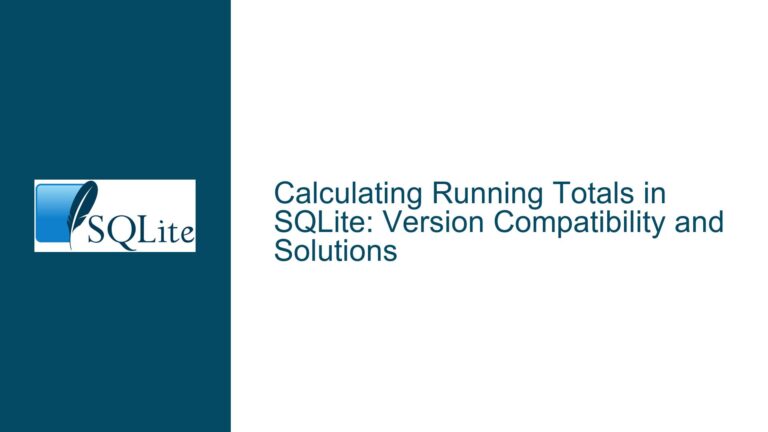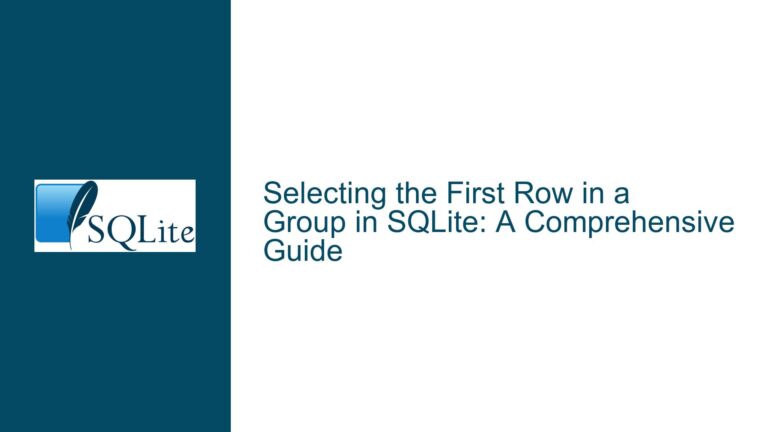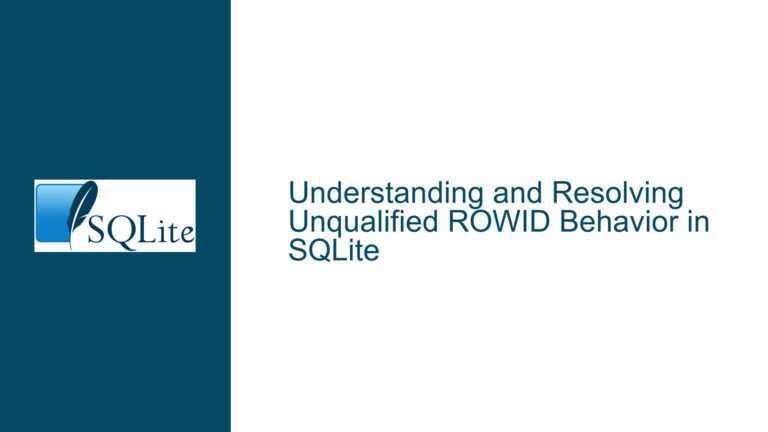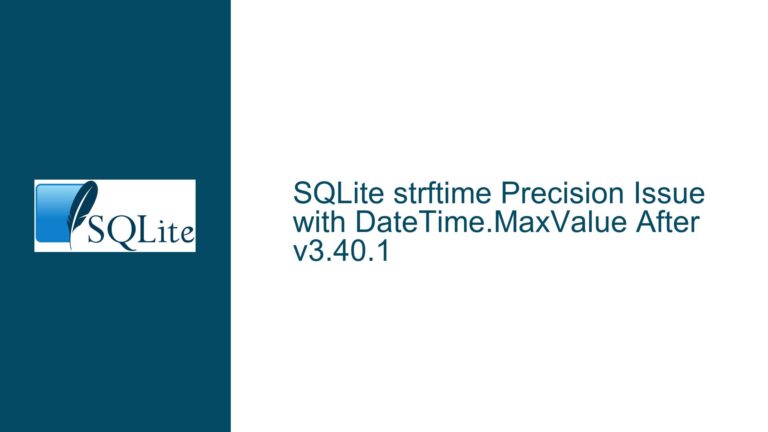Handling Negative Trip Durations in SQLite Queries
Issue Overview: Miscalculating Time Intervals Due to Date Order Assumptions
When working with time-based data in SQLite, a common requirement is to calculate the duration between two timestamps, such as the difference between the start and end times of a trip. The core challenge arises when the underlying data contains inconsistencies where the end timestamp (ended_at) precedes the start timestamp (started_at), leading to negative duration values. SQLite’s lack of a built-in DATEDIFF function for granular time unit calculations (e.g., minutes, hours) complicates this further, requiring developers to rely on alternative date/time functions like julianday() or strftime() to compute intervals. The original approach using a CASE statement to conditionally swap timestamp arguments when a negative duration is detected introduces unnecessary complexity and risks masking deeper data integrity issues. This scenario demands a dual focus: resolving calculation logic and addressing root causes of timestamp inversions.
Possible Causes: Inverted Timestamps and Misuse of Date Functions
1. Data Integrity Violations:
The most fundamental cause of negative trip durations is invalid data where the ended_at value is earlier than started_at. This inversion violates the logical expectation that a trip’s end time follows its start time. Such anomalies may arise from:
- Input Errors: Manual data entry mistakes or incorrect API payloads.
- Time Zone Discrepancies: Timestamps recorded in different time zones without proper normalization.
- Clock Synchronization Issues: Devices recording timestamps with unsynchronized or incorrect system clocks.
2. Incorrect Date Difference Calculations:
SQLite’s date/time functions operate on Julian Day numbers or formatted strings, requiring explicit handling of time units. A frequent mistake is assuming the existence of a DATEDIFF function akin to other SQL dialects (e.g., MySQL, T-SQL). Without this function, developers often miscalculate intervals by:
- Misapplying
julianday(): Failing to multiply the Julian Day difference by the appropriate factor (e.g., 1440 for minutes, 86400 for seconds). - Overlooking
strftime()Formatting: Not usingstrftime('%s', ...)to extract Unix epoch seconds for interval calculations. - Ignoring Fractional Days: Treating
julianday()differences as whole numbers, discarding fractional day precision.
3. Logical Redundancy in Conditional Checks:
The use of a CASE statement to handle negative durations by swapping timestamp arguments is logically redundant. The absolute value of the difference can be obtained directly using ABS(), eliminating the need for conditional branching. This approach also avoids obscuring data quality issues by ensuring all negative durations are surfaced for investigation rather than silently corrected.
Troubleshooting Steps, Solutions & Fixes
Step 1: Validate Data Integrity for Timestamp Order
Before modifying query logic, verify that all ended_at values chronologically follow their corresponding started_at values. Execute a diagnostic query to identify invalid records:
SELECT COUNT(*) AS invalid_records
FROM detail
WHERE ended_at < started_at;
If this returns a non-zero count, investigate the root cause:
- Audit Data Sources: Review ETL pipelines, application code, or IoT device configurations for timestamp generation errors.
- Normalize Time Zones: Convert all timestamps to a unified time zone (e.g., UTC) using
datetime()with a modifier:UPDATE detail SET started_at = datetime(started_at, 'utc'), ended_at = datetime(ended_at, 'utc'); - Correct Inverted Timestamps: For confirmed invalid records, swap started_at and ended_at:
UPDATE detail SET started_at = ended_at, ended_at = started_at WHERE ended_at < started_at;
Step 2: Implement Robust Date Difference Calculations
SQLite requires explicit handling of date differences. To calculate trip duration in minutes:
SELECT
ROUND((julianday(ended_at) - julianday(started_at)) * 1440) AS duration_minutes
FROM detail;
For Unix epoch-based calculations (seconds since 1970-01-01):
SELECT
(strftime('%s', ended_at) - strftime('%s', started_at)) / 60 AS duration_minutes
FROM detail;
Key Considerations:
- Precision Handling: Use
ROUND(),FLOOR(), orCEIL()as needed to handle fractional minutes. - Leap Seconds:
julianday()accounts for leap seconds;strftime('%s')does not. Choose based on precision requirements.
Step 3: Simplify Logic Using Absolute Values
Replace the CASE statement with ABS() to ensure non-negative durations while preserving the original timestamp order:
SELECT
ABS(ROUND((julianday(ended_at) - julianday(started_at)) * 1440)) AS duration_minutes
FROM detail;
Advantages:
- Code Simplicity: Eliminates conditional branching, improving readability and maintainability.
- Performance: Reduces computational overhead by avoiding per-row conditional checks.
Step 4: Enforce Timestamp Order Constraints
Prevent future data integrity issues by adding a CHECK constraint to the table:
ALTER TABLE detail
ADD CHECK (ended_at >= started_at);
For existing tables, recreate with the constraint:
CREATE TABLE detail_new (
-- existing columns
started_at TEXT NOT NULL,
ended_at TEXT NOT NULL,
CHECK (ended_at >= started_at)
);
INSERT INTO detail_new SELECT * FROM detail;
DROP TABLE detail;
ALTER TABLE detail_new RENAME TO detail;
Step 5: Handle Edge Cases with Time Zones and Nulls
Time Zone Normalization:
If timestamps include time zone offsets (e.g., 2021-07-28 12:00:00+04:00), convert them to a standard zone before storage:
UPDATE detail
SET started_at = datetime(started_at, 'utc'),
ended_at = datetime(ended_at, 'utc');
Null Handling:
Ensure started_at and ended_at are non-nullable and add default values if appropriate:
CREATE TABLE detail (
-- other columns
started_at TEXT NOT NULL DEFAULT CURRENT_TIMESTAMP,
ended_at TEXT NOT NULL
);
Step 6: Benchmark and Optimize Large-Scale Queries
For datasets exceeding 100,000 rows, optimize performance by:
- Indexing Timestamp Columns:
CREATE INDEX idx_detail_started ON detail(started_at); CREATE INDEX idx_detail_ended ON detail(ended_at); - Batch Processing: Use
LIMITandOFFSETto paginate results and avoid memory bottlenecks.
Step 7: Implement Comprehensive Logging and Alerts
Monitor for timestamp anomalies using triggers:
CREATE TRIGGER validate_timestamps_before_insert
BEFORE INSERT ON detail
BEGIN
SELECT
CASE
WHEN NEW.ended_at < NEW.started_at THEN
RAISE(ABORT, 'ended_at must be greater than or equal to started_at')
END;
END;
Log invalid insertion attempts to an audit table:
CREATE TABLE timestamp_audit (
id INTEGER PRIMARY KEY,
invalid_started_at TEXT,
invalid_ended_at TEXT,
attempted_at TEXT DEFAULT CURRENT_TIMESTAMP
);
CREATE TRIGGER log_invalid_timestamps
AFTER INSERT ON detail
WHEN NEW.ended_at < NEW.started_at
BEGIN
INSERT INTO timestamp_audit (invalid_started_at, invalid_ended_at)
VALUES (NEW.started_at, NEW.ended_at);
END;
Final Query Optimization
Combine all improvements into a single efficient query:
SELECT
ABS(ROUND((julianday(ended_at) - julianday(started_at)) * 1440)) AS duration_minutes
FROM detail
WHERE ended_at >= started_at -- Exclude pre-corrected invalid data
UNION ALL
SELECT
ABS(ROUND((julianday(started_at) - julianday(ended_at)) * 1440)) AS duration_minutes
FROM detail
WHERE ended_at < started_at; -- Handle historical invalid data
By systematically addressing data integrity, refining date calculations, and simplifying conditional logic, this approach ensures accurate trip duration calculations while maintaining scalability and performance.






